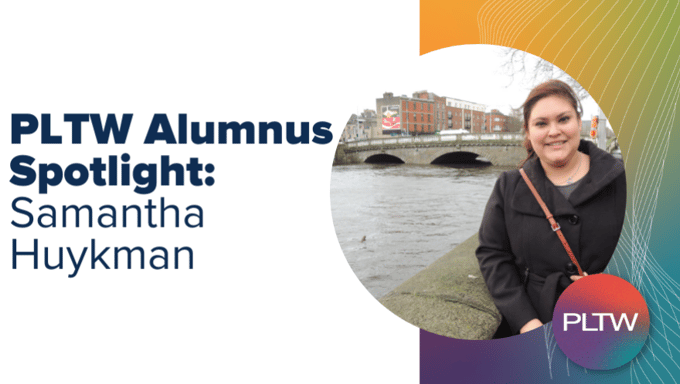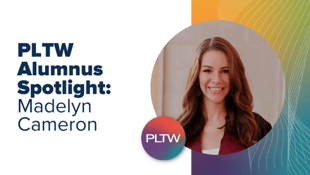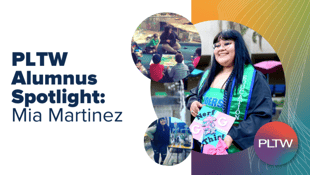For nearly 25 years, PLTW has offered transformative classroom and learning experiences for PreK-12 students. Now, many of those students are professionals in STEM fields. We recently reached out to several PLTW alumni to learn more about their educational and career journeys and find out what advice they have for current PLTW students. If you are a PLTW alumnus interested in sharing your story, we’d love to hear from you here.
Samantha Huykman lives in New Braunfels, Texas and is a Geographic Information Systems (GIS) Analyst at the Guadalupe Blanco River Authority (GBRA). In high school, Samantha completed Principles of Engineering, Introduction to Engineering Design, Civil Engineering and Architecture, and Engineering Design and Development in the PLTW Engineering program.
In what grades did you participate in PLTW? What were some of your most memorable experiences from PLTW?
I participated in the PLTW Engineering program all four years of high school. Some of my favorite memories are definitely the Engineering Olympics where I built a bottle rocket, a hydraulic crane, and, my all-time favorite, a cardboard raft that I created with a team using nothing but cardboard and tape in a few hours then competing with other teams to paddle across the pool. I also had great times in our engineering courses and enjoyed actually being challenged to think of innovative solutions. My senior project in Engineering Design and Development focused on developing an alternative design of a catalytic converter that would replace the precious metals inside the core, which is the cause of most catalytic converter thefts.
What did your journey look like to get to where you are today?
I went down a few different paths before finding what I was meant to do professionally. I interned a few summers through STEM programs with the Frank H. Dotterweich College of Engineering at Texas A&M University – Kingsville, which introduced me to the diverse types of engineering. During these internships, I gravitated toward environmental engineering specifically but felt called more toward environmental science instead of engineering. When it came time to look at colleges, I ended up touring Stephen F. Austin State University (SFA) in Nacogdoches, Texas and fell in love with the campus and Arthur Temple Forestry College where I would be spending the majority of my time as an environmental science major.
In my second semester of college, I had a teaching assistant leading our forest ecology lab who was working on her graduate degree in GIS and had just returned from an internship in Alaska. I recalled visiting a few of the local colleges and universities in Corpus Christi for GIS Day events and presentations back in high school but hadn’t given it too much thought back then. After talking with her and half an Introduction to GIS course later, I changed my major to spatial science. I began to comprehend the diversity of GIS applications in almost every industry and the perfect left and right brain balance GIS provided. During one of the summers, I was offered an internship with Harris County Sheriff’s Department in Houston, Texas as a GIS Technician where I was able to work with the data that feeds into the 911 systems and automating workflows for updating the data in the computer aided dispatch (CAD) system. The following summer, I was recommended to repeat the work I did with Harris County for the City of Pasadena Police Department in Pasadena, Texas.
I graduated from SFA as a double major in spatial science and geography in three and a half years. While I initially planned on going into public safety after graduation, I ended up accepting a GIS position in the oil and gas industry at the corporate office of a midstream pipeline company in San Antonio, Texas. Since GIS can be a strategic tool when applied in almost any field, our central location in the company allowed me to gain exposure throughout the lifetime of a project. I worked with business development managers in researching properties, other pipelines, pipeline routing opportunities, and creating maps they used when meeting with potential clients. If a project continued from there, I worked with right-of-way, engineering, and construction for tracking negotiations and construction progress. Finally, when construction was complete, I worked with regulatory and operations to provide support in managing the data we had of our assets or producing deliverables required by governing agencies. Somehow through all this, I decided to begin graduate school and started working part-time on my Master of Business Administration focusing in quality management. After almost five years, I went on to work for a pipeline surveying company where I had the opportunity to learn more about the surveying and construction side of pipelines. After a little over a year after that, the stress of the oil and gas industry began to take a toll on me and I began searching for an opportunity that would allow me to change industries, which led me to where I am now.
What is your current role within your company? What are your responsibilities in this position?
I joined GBRA only a short time ago, but it has definitely brought me back to my environmental roots and has allowed me to combine that with my knowledge of pipelines and how they operate. It is the best of both worlds in my biased opinion. As a GIS professional, you also have to think of how you can help a process, or if there is anything you can provide from the data in the system that can help your organization. My role as a GIS Analyst continues to place me in a central location within the organization where I have the opportunity of working with business development, engineering, operations, and even with some of the great folks who manage our parks. As a river authority in the State of Texas, we have the pleasure of providing water resources and wastewater solutions to the community. As new communities are continuously being developed in Texas, one of my responsibilities is to map service pipelines for the new communities. Once mapped in GIS, this pipeline data is then available throughout the organization to be used in Supervisory Control Data Acquisition (SCADA) which monitors and controls the volumes inside the pipelines, asset management for maintaining the integrity of the assets, operations when they respond to issues or conduct maintenance, and even records management. I also get to do a lot of cartographic work by making maps for board presentations or for the hiking kiosk stations at our parks. My responsibilities definitely have a range of tasks but to name a few I would say assisting maintain our databases, publishing web services for our web maps and viewers, collecting data in the field and facilities with GPS units, or providing troubleshooting support for users of our system. No day is exactly the same as the last, which is an added bonus for me.
What did you learn in PLTW that still helps you today?
PLTW actually taught me that I’m the kind of person who needs to be challenged in order to stay engaged. I knew before going into college that I needed to pursue a career where I was challenged and forced to think creatively. On that note, I also learned how to think creatively and develop innovative solutions and evolve those solutions by working with teams. Also, through all my coursework, I learned how not to be afraid to ask questions. If you are learning something new, it’s better to ask questions from the people who know the answers and don’t mind sharing their knowledge with you, than to never learn at all.
Do you have any advice for current PLTW students?
I encourage students to enjoy themselves and to be curious. Look into different careers and the education or certifications necessary for those jobs, investigate the out of the box careers that most people have never even thought of, and if you are like me and need a challenge to stay engaged, find a job that challenges you daily, so you never get bored. It makes Mondays more enjoyable – I promise. Set goals for yourself and remind yourself of them when life throws you curveballs so you can always stay motivated to work towards those goals. Lastly... learn how to study before getting to college. Find a studying technique that works best for you, and it will make all the difference during those rigorous courses.
Anything else you’d like to add?
I was speaking with Dr. David Dimmit from PLTW, when I came to the realization that without PLTW, I’m not too sure I would have found my way to where I am today, or if I had, it definitely would have taken me a lot longer than it did. PLTW and the PLTW Engineering program gave me direction much earlier in life than most and the opportunity to identify my strengths in a STEM field and pursue a STEM career. Figuring out what you want to be at a young age is a difficult choice, but PLTW made it a lot less difficult for me.
__
PLTW provides PreK-12 schools, teachers, and students with hands-on, interdisciplinary STEM-based curriculum that uniquely prepares students for life and their future careers.
PLTW rejuvenates teachers, providing world-class experiences that keep them on the forefront of how to prepare students for the demands of tomorrow. PLTW:
- Has provided professional development opportunities to more than 80,000 teachers giving them the support and resources needed to inspire students
- Offers best-in-class teacher training: PLTW Core Training with Master Teachers
- Continuously updates teacher resources that are available on demand
- Facilitates teacher networking opportunities
- Develops curriculum by a team of writers, many of whom are former teachers


